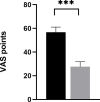Extracorporeal cytokine adsorption: Significant reduction of catecholamine requirement in patients with AKI and septic shock after cardiac surgery
- PMID: 33556101
- PMCID: PMC7870055
- DOI: 10.1371/journal.pone.0246299
Extracorporeal cytokine adsorption: Significant reduction of catecholamine requirement in patients with AKI and septic shock after cardiac surgery
Abstract
Background: Extracorporeal cytokine adsorption is an option in septic shock as an additional measure to treat a pathological immune response. Purpose of this study was to investigate the effects of extracorporeal cytokine adsorption on hemodynamic parameters in patients with acute kidney injury (AKI) on continuous renal replacement therapy (CRRT) and septic shock after cardiac surgery.
Methods: In this retrospective study, a total of 98 patients were evaluated. Hemoadsorption was performed by the CytoSorb® adsorber. In all patients cytokine adsorption was applied for at least 15 hours and at least one adsorber was used per patient. To compare cumulative inotrope need in order to maintain a mean arterial pressure (MAP) of ≥ 65 mmHg, we applied vasoactive score (VAS) for each patient before and after cytokine adsorption. A paired t-test has been performed to determine statistical significance.
Results: Before cytokine adsorption the mean VAS was 56.7 points. This was statistically significant decreased after cytokine adsorption (27.7 points, p< 0.0001). Before cytokine adsorption, the mean noradrenalin dose to reach a MAP of ≥ 65 mmHg was 0.49 μg/kg bw/min, the mean adrenalin dose was 0.12 μg/kg bw/min. After cytokine adsorption, significantly reduced catecholamine doses were necessary to maintain a MAP of ≥ 65 mmHg (0.24 μg/kg bw/min noradrenalin; p< 0.0001 and 0.07 μg/kg bw/min adrenalin; p < 0.0001). Moreover, there was a significant reduction of serum lactate levels after treatment (p< 0.0001). The mean SOFA-score for these patients with septic shock and AKI before cytokine adsorption was 16.7 points, the mean APACHE II-score was 30.2 points. The mean predicted in-hospital mortality rate based on this SOFA-score of 16.7 points was 77,0%, respectively 73,0% on APACHE II-score, while the all-cause in-hospital mortality rate of the patients in this study was 59.2%.
Conclusion: In patients with septic shock and AKI undergoing cardiac surgery, extracorporeal cytokine adsorption could significantly lower the need for postoperative inotropes. Additionally, observed versus SOFA- and APACHE II-score predicted in-hospital mortality rate was decreased.
Conflict of interest statement
The authors have read the journal’s policy and have the following competing interests: Bartosz Tyczynski and Daniel Wendt have received financial support (travel funds and speaker´s fees) from CytoSorbents. Andreas Kribben has received grants for clinical studies, speaker’s fee, honoraria and travel expenses from Actelion, Amgen, Amicus, Alexion, Astellas, Bayer, Baxter, Binding Site, Bristol Myers, Chiesi, CytoSorbents, Fresenius, GlaxoSmithKline, Hexal, Janssen, Kyowa Kirin, MSD, Novartis, Otsuka, Peripal, Pfizer, Roche, Sanofi, Shire, Teva, and Vifor Fresenius Medical. There are no patents, products in development or marketed products associated with this research to declare. This does not alter our adherence to PLOS ONE policies on sharing data and materials.
Figures





References
MeSH terms
Substances
LinkOut - more resources
Full Text Sources
Other Literature Sources
Medical

